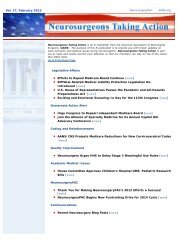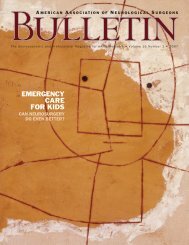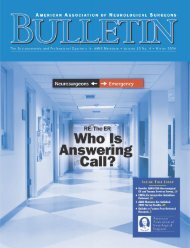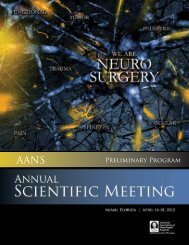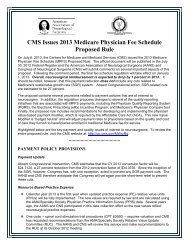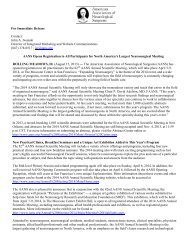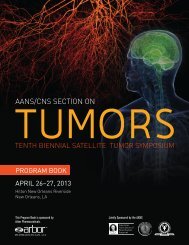view PDF - American Association of Neurological Surgeons
view PDF - American Association of Neurological Surgeons
view PDF - American Association of Neurological Surgeons
Create successful ePaper yourself
Turn your PDF publications into a flip-book with our unique Google optimized e-Paper software.
N EWSLINE<br />
NewsMembersTrendsLegislation<br />
Medical Liability<br />
Reform Legislation Falls<br />
Short in U.S. Senate<br />
On May 8 the U.S.<br />
Senate voted on two<br />
medical liability reform<br />
bills. Both bills failed to<br />
gain the necessary support<br />
to move forward in<br />
the legislative process.<br />
See Washington Update,<br />
page 26.<br />
3 IOM Issues Three Reports on Emergency Medical Care On June 14 the Institute <strong>of</strong> Medicine issued<br />
three reports related to the Future <strong>of</strong> Emergency Care in the U.S. project. The report <strong>of</strong> most relevance<br />
to neurosurgeons, Hospital-Based Emergency Care: At the Breaking Point, explores the changing<br />
role <strong>of</strong> the hospital emergency department and describes the national epidemic <strong>of</strong> overcrowded<br />
emergency departments and trauma centers. This report <strong>of</strong>fers an assessment <strong>of</strong> the emergency care<br />
workforce, including specialists who provide on-call emergency and trauma care services. To help<br />
improve the availability <strong>of</strong> on-call physicians, the IOM recommends a number <strong>of</strong> remedies that<br />
include improved reimbursement for emergency services, medical liability reform, regionalization <strong>of</strong><br />
certain emergency specialty services, and creation <strong>of</strong> a new specialty called acute care surgery. The<br />
AANS opposes the establishment <strong>of</strong> an acute care surgical specialty if these specialists are intended<br />
to perform neurosurgical procedures. The three IOM reports—Hospital-Based Emergency Care: At<br />
the Breaking Point, Emergency Medical Services at the Crossroads and Emergency Care for Children:<br />
Growing Pains—are available a www.iom.edu. Neurosurgical involvement in the emergency medical<br />
system is the subject <strong>of</strong> this issue’s cover section, beginning on page 8, and the editor’s Personal<br />
Perspective, page 7.<br />
3 AANS, CNS and ASTRO Define SRS In April the AANS Board <strong>of</strong> Directors, the Executive Committee <strong>of</strong><br />
the Congress <strong>of</strong> <strong>Neurological</strong> <strong>Surgeons</strong> and the Board <strong>of</strong> Directors <strong>of</strong> the <strong>American</strong> Society for<br />
Therapeutic Radiology and Oncology agreed on a contemporary definition <strong>of</strong> stereotactic radiosurgery.<br />
This position statement follows and also is published online at www.AANS.org, article ID 38198.<br />
3 Stereotactic radiosurgery is a distinct discipline that utilizes externally generated ionizing radiation<br />
in certain cases to inactivate or eradicate (a) defined target(s) in the head and spine without the need<br />
to make an incision. The target is defined by high-resolution stereotactic imaging. To assure quality<br />
<strong>of</strong> patient care the procedure involves a multidisciplinary team consisting <strong>of</strong> a neurosurgeon, radiation<br />
oncologist, and medical physicist.<br />
3 Stereotactic radiosurgery typically is performed in a single session, using a rigidly attached stereotactic<br />
guiding device, other immobilization technology and/or a stereotactic image-guidance system,<br />
but can be performed in a limited number <strong>of</strong> sessions, up to a maximum <strong>of</strong> five.<br />
3 Technologies that are used to perform stereotactic radiosurgery include linear accelerators, particle<br />
beam accelerators, and multisource Cobalt 60 units. In order to enhance precision, various devices<br />
may incorporate robotics and real time imaging.<br />
Send news briefs for<br />
Newsline to<br />
bulletin@AANS.org.<br />
3 AANS and CNS Seek Medicare Payment Policy Change for SRS <strong>of</strong> Multiple Lesions Beginning with<br />
Medicare carrier Noridian Administrative Services, which had issued a proposed Medicare coverage<br />
policy related to stereotactic radiosurgery that would affect its coverage area <strong>of</strong> more than 10 states,<br />
the AANS and Congress <strong>of</strong> <strong>Neurological</strong> <strong>Surgeons</strong> are urging Medicare carriers to adopt the AANS,<br />
CNS and ASTRO definition <strong>of</strong> SRS and to ensure that additional payments for SRS are made when<br />
a neurosurgeon treats more than one lesion. The AANS and CNS comments to Noridian state that<br />
Current Procedural Terminology “code 61793 is valued for treating a single lesion, whether or not<br />
that treatment requires multiple isocenters or multiple sessions. Under CPT and Medicare policy for<br />
multiple procedures, code 61793 may be reported multiple times for multiple lesions, using 61793<br />
alone for the first lesion and 61793 appended by modifier 59 or modifier 51. This code should not<br />
be reported more than five times for any session. Any additional sessions (up to five) for the same<br />
lesion(s) are inclusive <strong>of</strong> CPT 61793. If any lesion requires multiple isocenters and/or requires more<br />
complex targeting, then code 61793 should be reported appended by modifier 22.”<br />
Vol. 15, No. 2 • 2006 • AANS Bulletin 5




